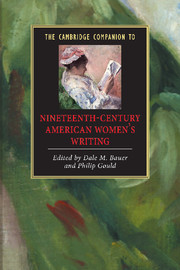Introduction
Published online by Cambridge University Press: 28 May 2006
Summary
Writing in response to the question “How Should Women Write?” (1860), Mary Bryant prescribed a literature that would be at once intellectual and intense, written “honestly and without fear” to suit the seriousness of the era. This volume is our effort to meet Bryant’s challenge, to bring her charge to bear on the history of American women’s writing and the legacy of and prospects for its criticism to date.
Once dismissed as simply sentimental and thus undeniably inferior, nineteenth- century American women’s writing, for at least the last twenty years, has been newly “recovered” or “rediscovered.” The critical occasion for the Cambridge Companion to Nineteenth-Century American Women’s Writing derives of course from the extensive revitalization of this scholarly discipline. Yet this volume also provides an account of the changing critical assumptions that govern the contemporary study of American women’s writing itself.
Contemporary reappraisals of nineteenth-century American women’s writing have changed both the shape of the American literary canon and the discipline of American literary history. Influential studies abound, from Ann Douglas’s The Feminization of American Culture (1977) and Nina Baym’s Woman’s Fiction: a Guide to the Novels by and about Women in America, 1820–1870 (1978, 1993) to Jane Tompkins’s Sensational Designs: The Cultural Work of American Fiction, 1790–1860 (1985) and Cathy N. Davidson’s Revolution and the Word: the Rise of the Novel in America (1986).
- Type
- Chapter
- Information
- Publisher: Cambridge University PressPrint publication year: 2001
- 1
- Cited by



